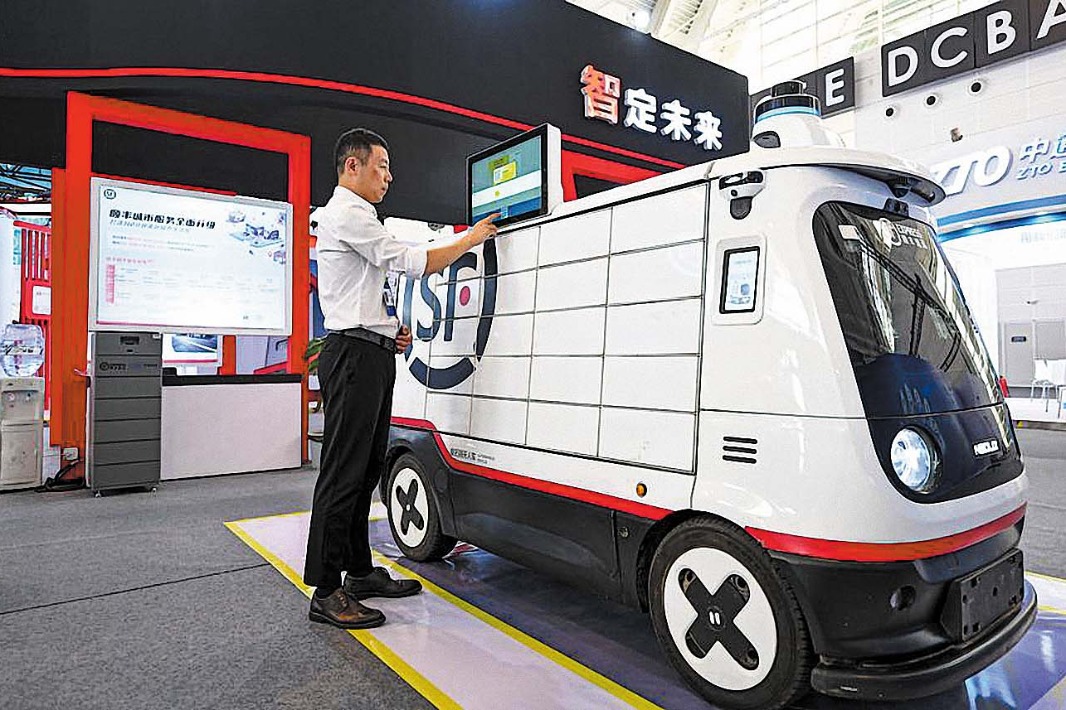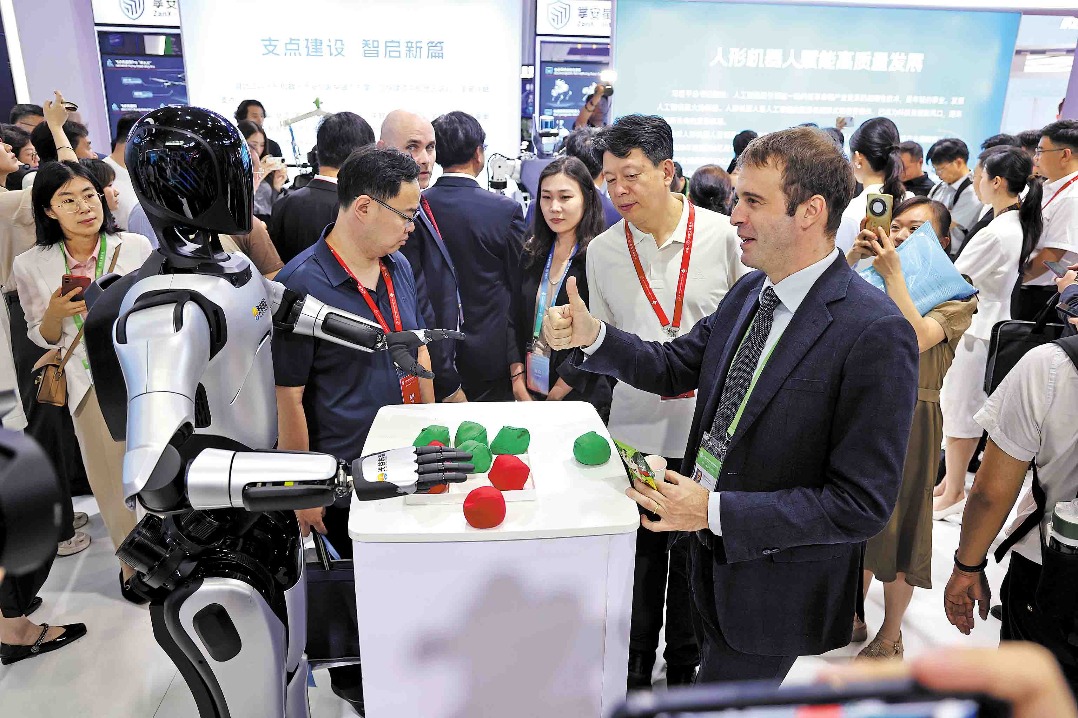Self-driving tech fueled by innovation
Nation's collaborative approach helps advance connected vehicle services


As China strives for technological innovation represented by intelligent connected vehicles and autonomous driving, it has created a distinctive Chinese innovation model, with government departments, enterprises and research institutions collaborating closely and policies being drafted to support the nation's technological growth, said experts, entrepreneurs and officials.
Zhao Xiangmo, vice-chairman of the China Society of Automotive Engineers, said that with the development of new energy vehicles and self-driving tech, the automotive industry is undergoing a qualitative change.
As self-driving vehicles become more prominent, China's solution is vehicle-road-cloud integration, which is a technology more complex than the single-vehicle intelligence explored by the United States 30 years ago, said Zhao, who is also president of the Xi'an University of Architecture and Technology in Shaanxi province.
Vehicle-road-cloud integration uses artificial intelligence and technologies such as cellular vehicle-to-everything, or C-V2X, and 5G to enable seamless collaboration between humans, vehicles, roads and cloud systems.
Zhao attributes China's success in the field of intelligent driving to its unique path of independent innovation, which has mobilized various forces from government departments, automotive companies, cloud computing enterprises and research institutions to achieve collaborative development under a top-level framework.
"This is a vast technological system involving vehicle, road, internet and cloud computing, in which each segment can drive an industry. It's impossible to proceed without teamwork. This is also a typical area where new quality productive forces are concentrated," he said.
The third plenary session of the 20th Central Committee of the Communist Party of China held last month emphasized the need to coordinate the construction of various scientific and technological innovation platforms, encourage and regulate the development of new research and development institutions, leverage the leading role of China's huge market, strengthen the coordination of innovative resources and organizational strength, and promote the integration of technological innovation and industrial innovation.
In September 2020, the Beijing municipal government decided to establish the world's first high-level autonomous driving demonstration zone, featuring vehicle-road-cloud integration, in the Beijing Economic-Technological Development Area.
Beijing Connected and Autonomous Vehicles Technology Co was set up as the operating platform, in conjunction with the National Innovation Center of Intelligent and Connected Vehicles and other research and development institutions, forming a structure involving government departments, academia, industries and investors among other entities.
Pony.ai, an autonomous driving research and development company that started operating in Silicon Valley in 2016, established its first domestic research center in the Beijing Economic-Technological Development Area in 2017, becoming one of the first companies to have a presence in the demonstration zone.
"The construction of the demonstration zone has accelerated Pony.ai's research and testing," said Zhang Ning, vice-president of the company and head of its Beijing research center. "On average, there is a technological breakthrough or policy move every three months — a pace that is exhilarating."
One of Pony.ai's main businesses involves the Robotaxi, an autonomous taxi service. In 2018, the company obtained a testing license and began conducting trial runs with a safety officer in the driver's seat. In April 2021, the officer moved to the passenger seat; in July 2022, to the back seat; and by the end of that year, "fully driverless" tests were successfully conducted.
"After accumulating enough testing data, following evaluation by the demonstration zone's management committee, Pony.ai started providing Robotaxi services for a fee since last year. Now, anyone in the demonstration zone can hail a ride in these taxis using their mobile phone," Zhang said.
Currently, only China and the US have achieved commercial operation of self-driving taxis, he noted. While Google's Waymo has undergone 15 years of development, China has made rapid progress in the past five years, thanks to the close cooperation between government departments, enterprises and research institutions.
"The resonance between policy and technological innovation is crucial. The government acts as a guiding beacon, boosting the confidence of enterprises and promoting technological development through funding and policies. This is how the Robotaxi has achieved such rapid development in such a short time," Zhang said.
"The testing data accumulated by enterprises serves as a reference for government policymaking, with the government overseeing and making decisions to share the risks with enterprises," he added.
Zhang said he believes that the potential of developing the Robotaxi service in China's major cities is at least 10 times greater than in US cities such as San Francisco, because the population in major Chinese cities is larger.
"Moreover, China's roads are more complex. After training in such situations, the nation's autonomous driving tech will be far more competitive when exported to other countries," he said.
In the field of autonomous driving, China's commercialization landscape and future market will be much larger than those of the US, he added.
On public roads, Pony.ai has achieved 35 million kilometers of real-world autonomous driving efficiency. "It's equivalent to the driving experience of dozens of ordinary drivers in a lifetime," Zhang said, adding that data shows Robotaxis are 10 times safer than taxis driven by humans.
Yuan Chengyin, director and general manager of the National New Energy Vehicle Technology Innovation Center, said: "In the development process of intelligent driving in China, what I deeply appreciate is the Chinese innovation model of tackling key issues. It's somewhat like passing a baton in foreign countries, but under our government initiatives it requires integrating all resources to focus fully on completing a task with a clear purpose and determination."
Yuan, who is also secretary-general of the China Automotive Chip Industry Innovation Strategic Alliance, said that this year, the percentage of car chips produced domestically for China's use will increase from 5 percent to 20 percent.
Over the past four years, the demonstration zone in Beijing has introduced more than 30 companies for research and development of autonomous driving tech and intelligent connected functions, deploying over 800 autonomous vehicles for testing, resulting in more than 60 standard achievements, according to the zone's management committee.
The demonstration zone has established the nation's first domestic standard system for vehicle-road0cloud integration, with vehicles such as self-driving taxis, unmanned delivery vans and unmanned cleaning trucks already in operation.

Online See more by scanning the code.





































